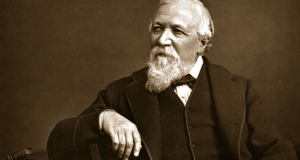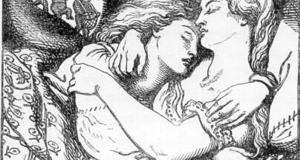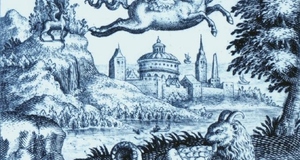|
Apocalyptic Imagery in Aurora Leigh
This wedding is also unconventional in its apocalyptic symbolism. Romney is often compared to Christ, as he comes to Aurora in Book VIII to redeem her. With “the sound of waters . . . in [her] ears,” Aurora calls him “my king” (VIII.60-61, 63), invoking Christ’s Second Coming. As Romney’s bride, Aurora appears in the final scenes as both the bride of Christ and the New Jerusalem, “prepared as a bride beautifully dressed for her husband” (Revelation 21:2). This apocalyptic image parallels the first book’s action. However, Aurora is also compared to Christ, for Romney calls her his “morning-star” (22:16). In the final scenes, it is Aurora who invokes the New Jerusalem and who will, in their marriage, “work for two” (IX.911). The conventional marriage roles are reversed here. However, both still admit their need for God, who alone can redeem men’s souls and earthly societies. The result is a simultaneously traditional and internal apocalypse that relies on divine providence.
This apocalypse distinguishes between prophet and seer. While Hebrew prophets saw visions pertaining to Israel’s destruction and renewal, the Christian Apocalypse of Revelation transformed these prophecies into visions describing a cosmic struggle, cataclysmic destruction, and end-of-the-world renewal. English and German Romantics transformed this apocalypse into a secular one by emphasizing “the philosophic, social, or poetic seer who demonstrates the way to a secular redemption” (Abrams 358). Barrett Browning’s Aurora Leigh continues in this vein, with Aurora as a “poetic seer,” but her role is described in both Hebrew and Christian terms. Because Aurora and Romney’s New Jerusalem is an “apocalypse within,” it appears secular; however, its structure is Christian, as is Aurora and Romney’s emphasis on divine redemption.
Aurora assumes the roles of both prophet and seer in her calling as a poet. She explains that as young children “we hide our eyes / And think all ended. – Then, Life calls to us / In some transformed, apocalyptic voice” (I.672-74). Whether that voice is “nature” or “love” she cannot tell (I.676). Aurora knows that a poet must be both a prophet who “teaches in the roads,” and a seer who “pulls down the flaming heavens / Upon his own head in strong martyrdom / In order to light men a moment’s space” (I.762-65). Such a poet must symbolically bring heaven down to earth in apocalyptic renewal. As a poet-prophet-seer, Aurora is one “of the only truth-tellers now left to God, / The only speakers of essential truth” (I.859-60). She must be “the poet, speaker, [who] expands with joy, / The palpitating angel in his flesh” (I.911-12). The poet must assume the dual roles of both angel and John of Patmos. However, only with the death of her aunt, phrased in apocalyptic terms, can Aurora become a poet: “On the sixth week, the dead sea broke up, / Dashed suddenly through beneath the heel of Him / Who stands upon the sea and earth and swears / Time shall be nevermore” (II. 896-99).
As poet, Aurora is compared to both Hebrew and Christian prophets. Fearing Marian will accept Romney’s proposal, Aurora envisions God’s heaven “as blue as Aaron’s priestly robe appeared / To Aaron when he took it off to die” (IX.253-54); her love for Romney will die with Marian’s acceptance. Aurora is also “Miriam” who envisions the symbolic destruction of London (III. 197-203), a role as prophetess that Romney recognizes (II.171). Aurora is even Elijah, with “art’s fiery chariot which we journey in / Being apt to singe our singing-robes to holes” (III.58-59), and Ezekiel, “fear[ing] to jingle bells upon my robe / Before the four-faced silent cherubim” (VII.1303-05). Finally, she is John of Patmos, turning to see Romney-Christ and hearing “in my ears / The sound of waters” (VIII.60-61). Like John, Aurora is forbidden to write down some visions: “What he said, / I fain would write. But if an angel spoke / In thunder. . .” (IX.737-39). Aurora sees herself as the poet who “says the word so that it burns you through / With a special revelation, shakes the heart / Of all the men and women in the world” (I.905-07). This is a role that most prophets, John of Patmos included, have assumed. However, Aurora’s revelation does not come to fruition until her marriage to Romney.
Throughout Aurora Leigh, but especially during Aurora and Romney’s invocation of the vision of the New Jerusalem, Aurora is both Hebrew prophet and apocalyptic scribe of heavenly visions. However, although she is often compared to biblical prophets and scribes, even Christ, Aurora is still not Christ and neither is Romney. Their marriage is symbolic of Christ and his church-bride but does not equal that divine union. Instead, both Aurora and Romney need Christ himself to redeem society. When they live and work in conjunction with him, then their plans of social renewal will succeed, with Aurora as poet-prophet and Romney as Christ. Therefore, the apocalyptic nature of Barrett Browning’s Aurora Leigh is both Christian and secular, traditional and innovative. Unlike many Romantics, she does not forsake Christian apocalyptic imagery. Barrett Browning does, however, give up the traditional understanding of the Apocalypse: the end of the world, Christ’s second coming, and the New Jerusalem. The result is Aurora Leigh, a work both Victorian and Romantic in style and both innovative and traditional for its time.
Abrams, M. H. “Apocalypse: Theme and Variations.” The Apocalypse in English Renaissance Thought and Literature: Patterns, Antecedents, and Repercussions. Eds. C. A. Patrides and Joseph Wittreich. Ithaca, NY: Cornell UP, 1984. 342-68.
Avery, Simon, and Rebecca Stott. Elizabeth Barrett Browning. Studies in Eighteenth- and Nineteenth-Century Literature. Ed.Andrew Sanders. London: Longman Pearson, 2003.
Bidney, Martin. Patterns of Epiphany: From Wordsworth to Tolstoy, Pater, and Barrett Browning. Carbondale: Southern Illinois UP, 1997.
Browning, Elizabeth Barrett. Aurora Leigh. Ed. Margaret Reynolds. Athens: Ohio UP, 1992.
---. The Poetical Works of Elizabeth Barrett Browning: Oxford Complete Edition. London: Henry Frowde, 1904.
Cooper, Helen. Elizabeth Barrett Browning, Woman and Artist. Chapel Hill: U of North Carolina P, 1988.
Falk, Alice. “Elizabeth Barrett Browning and Her Prometheuses: Self-Will and a Woman Poet.” Tulsa Studies in Women’s Literature 7.1 (1988): 69-85.
Forster, Margaret. Elizabeth Barrett Browning: A Biography. New York: Doubleday, 1989.
Gilbert, Sandra M., and Susan Gubar. The Madwoman in the Attic: The Woman Writer and the Nineteenth-Century Literary Imagination. 2nd ed. New Haven: Yale UP, 2000.
---. The War of the Words. No Man’s Land: The Place of the Woman Writer in the Twentieth Century. Vol 1. New Haven: Yale UP, 1988.
The Holy Bible. New International Version. Grand Rapids, MI: Zondervan, 1991.
Karlin, Daniel, ed. Robert Browning and Elizabeth Barrett: The Courtship Correspondence, 1845-1846. Oxford, UK: Clarendon Press, 1989.
Kelley, Philip, and Ronald Hudson, eds. The Brownings’ Correspondence. 5vols. Winfield, KS: Wedgestone Press, 1984.
Kenyon, Frederic G., ed. The Letters of Elizabeth Barrett Browning. 2vols. New York: Macmillan, 1897.
Leighton, Angela. Elizabeth Barrett Browning. Key Women Writers. Ed.Sue Roe. Bloomington: Indiana UP, 1986.
Lewis, Linda M. Elizabeth Barrett Browning’s Spiritual Progress: Face to Face with God. Columbia: U of Missouri P, 1998.
Mermin, Dorothy. Elizabeth Barrett Browning: The Origins of a New Poetry. Women in Culture and Society. Ed. Catharine R. Stimpson. Chicago: U of Chicago P, 1989.
Omer, Ranen. “Elizabeth Barrett Browning and Apocalypse: The Unraveling of Poetic Autonomy.” Texas Studies in Literature and Language 39.2 (1997): 97-124.
Reynolds, Margaret, ed. Aurora Leigh. Critical Introduction. Athens: Ohio UP, 1992. 1-77.
Rosenblum, Dolores. “Casa Guidi Windows and Aurora Leigh: The Genesis of Elizabeth Barrett Browning’s Visionary Aesthetic.” Tulsa Studies in Women’s Literature 4.1 (1985): 61-68.
Zonana, Joyce. “The Embodied Muse: Elizabeth Barrett Browning’s Aurora Leigh and Feminist Poetics.” Tulsa Studies in Women’s Literature 8.2 (1989): 240-62.
- See Cooper, Elizabeth Browning; Falk, “Elizabeth Browning and Her Prometheuses”; Leighton, Elizabeth Browning; Rosenblum, “Casa Guidi Windows and Aurora Leigh”; and Zonana, “The Embodied Muse.” Gilbert and Gubar, in The Madwoman in the Attic and No Man’s Land, mention the Apocalypse in passing.
- Letter to Mr. Westwood, Dec. 26, 1843
- Letter to Hugh Stuart Boyd, May 1828
- Letter to Henrietta Moulton-, Feb. 23-24, 1827 (Kelley and Hudson, II, 29-31); letter to H. S. Boyd, July 11, 1828 (Kelley and Hudson, II, 158-61)
- Letters to Hugh Stuart Boyd, March and May 28, 1828 (Kelley and Hudson, II)
- Letter to Robert Browning, July 16-17, 1845
- Letter to James Martin, Dec. 10, 1844
- Letter to Robert Browning, July 16-17, 1845
- April 20, 1855
- Letter to Miss E. F. Haworth, Jan. 1861
- Letter to Madame Braun, August 10, 1858
- Letter to Miss E. F. Haworth, Jan. 1861
- Letter to Madame Braun, August 10, 1858
- Letter to Mrs. Martin, April 20, 1855, in Kenyon, II., 194
- Early Poems, 1820-1833, 60-63 (The Poetical Works of Elizabeth Browning)
- See Revelation 10:3, 5-6; cf. Zechariah 14:3-8.
- Early Poems, 1820-1833, 67-68 (The Poetical Works of Elizabeth Browning)
- Miscellaneous Poems, 262-64 (The Poetical Works of Elizabeth Browning)
- Revelation 6:7-8
- I Corinthians 15:52
- In a Dec. 1850 letter to Ms. Mitford (Kenyon, vol. 1.), Barrett Browning says on Tennyson’s In Memoriam, “All I wish away is the marriage hymn at the end, and that for every reason I wish away – it’s a discord in the music” (472). By the time she composed Aurora Leigh, her views on marriage in apocalyptic poetry had changed.
- Revelation 6:12, 16:18
- Revelation 21:5
- Revelation 1:15
- Revelation 10:3, 5-6; Genesis 3:15
- 2 Kings 2:11-12
- Revelation 1:15
- Revelation 10:3-4
Abrams, M. H. “Apocalypse: Theme and Variations.” The Apocalypse in English Renaissance Thought and Literature: Patterns, Antecedents, and Repercussions. Eds. C. A. Patrides and Joseph Wittreich. Ithaca, NY: Cornell UP, 1984. 342-68.
Avery, Simon, and Rebecca Stott. Elizabeth Barrett Browning. Studies in Eighteenth- and Nineteenth-Century Literature. Ed.Andrew Sanders. London: Longman Pearson, 2003.
Bidney, Martin. Patterns of Epiphany: From Wordsworth to Tolstoy, Pater, and Barrett Browning. Carbondale: Southern Illinois UP, 1997.
Browning, Elizabeth Barrett. Aurora Leigh. Ed. Margaret Reynolds. Athens: Ohio UP, 1992.
---. The Poetical Works of Elizabeth Barrett Browning: Oxford Complete Edition. London: Henry Frowde, 1904.
Cooper, Helen. Elizabeth Barrett Browning, Woman and Artist. Chapel Hill: U of North Carolina P, 1988.
Falk, Alice. “Elizabeth Barrett Browning and Her Prometheuses: Self-Will and a Woman Poet.” Tulsa Studies in Women’s Literature 7.1 (1988): 69-85.
Forster, Margaret. Elizabeth Barrett Browning: A Biography. New York: Doubleday, 1989.
Gilbert, Sandra M., and Susan Gubar. The Madwoman in the Attic: The Woman Writer and the Nineteenth-Century Literary Imagination. 2nd ed. New Haven: Yale UP, 2000.
---. The War of the Words. No Man’s Land: The Place of the Woman Writer in the Twentieth Century. Vol 1. New Haven: Yale UP, 1988.
The Holy Bible. New International Version. Grand Rapids, MI: Zondervan, 1991.
Karlin, Daniel, ed. Robert Browning and Elizabeth Barrett: The Courtship Correspondence, 1845-1846. Oxford, UK: Clarendon Press, 1989.
Kelley, Philip, and Ronald Hudson, eds. The Brownings’ Correspondence. 5vols. Winfield, KS: Wedgestone Press, 1984.
Kenyon, Frederic G., ed. The Letters of Elizabeth Barrett Browning. 2vols. New York: Macmillan, 1897.
Leighton, Angela. Elizabeth Barrett Browning. Key Women Writers. Ed.Sue Roe. Bloomington: Indiana UP, 1986.
Lewis, Linda M. Elizabeth Barrett Browning’s Spiritual Progress: Face to Face with God. Columbia: U of Missouri P, 1998.
Mermin, Dorothy. Elizabeth Barrett Browning: The Origins of a New Poetry. Women in Culture and Society. Ed. Catharine R. Stimpson. Chicago: U of Chicago P, 1989.
Omer, Ranen. “Elizabeth Barrett Browning and Apocalypse: The Unraveling of Poetic Autonomy.” Texas Studies in Literature and Language 39.2 (1997): 97-124.
Reynolds, Margaret, ed. Aurora Leigh. Critical Introduction. Athens: Ohio UP, 1992. 1-77.
Rosenblum, Dolores. “Casa Guidi Windows and Aurora Leigh: The Genesis of Elizabeth Barrett Browning’s Visionary Aesthetic.” Tulsa Studies in Women’s Literature 4.1 (1985): 61-68.
Zonana, Joyce. “The Embodied Muse: Elizabeth Barrett Browning’s Aurora Leigh and Feminist Poetics.” Tulsa Studies in Women’s Literature 8.2 (1989): 240-62.
Endnotes
- See Cooper, Elizabeth Browning; Falk, “Elizabeth Browning and Her Prometheuses”; Leighton, Elizabeth Browning; Rosenblum, “Casa Guidi Windows and Aurora Leigh”; and Zonana, “The Embodied Muse.” Gilbert and Gubar, in The Madwoman in the Attic and No Man’s Land, mention the Apocalypse in passing.
- Letter to Mr. Westwood, Dec. 26, 1843
- Letter to Hugh Stuart Boyd, May 1828
- Letter to Henrietta Moulton-, Feb. 23-24, 1827 (Kelley and Hudson, II, 29-31); letter to H. S. Boyd, July 11, 1828 (Kelley and Hudson, II, 158-61)
- Letters to Hugh Stuart Boyd, March and May 28, 1828 (Kelley and Hudson, II)
- Letter to Robert Browning, July 16-17, 1845
- Letter to James Martin, Dec. 10, 1844
- Letter to Robert Browning, July 16-17, 1845
- April 20, 1855
- Letter to Miss E. F. Haworth, Jan. 1861
- Letter to Madame Braun, August 10, 1858
- Letter to Miss E. F. Haworth, Jan. 1861
- Letter to Madame Braun, August 10, 1858
- Letter to Mrs. Martin, April 20, 1855, in Kenyon, II., 194
- Early Poems, 1820-1833, 60-63 (The Poetical Works of Elizabeth Browning)
- See Revelation 10:3, 5-6; cf. Zechariah 14:3-8.
- Early Poems, 1820-1833, 67-68 (The Poetical Works of Elizabeth Browning)
- Miscellaneous Poems, 262-64 (The Poetical Works of Elizabeth Browning)
- Revelation 6:7-8
- I Corinthians 15:52
- In a Dec. 1850 letter to Ms. Mitford (Kenyon, vol. 1.), Barrett Browning says on Tennyson’s In Memoriam, “All I wish away is the marriage hymn at the end, and that for every reason I wish away – it’s a discord in the music” (472). By the time she composed Aurora Leigh, her views on marriage in apocalyptic poetry had changed.
- Revelation 6:12, 16:18
- Revelation 21:5
- Revelation 1:15
- Revelation 10:3, 5-6; Genesis 3:15
- 2 Kings 2:11-12
- Revelation 1:15
- Revelation 10:3-4
Suggested Reading from Inquiries Journal
Robert Browning’s two poems, “Porphyria’s Lover” and “My Last Duchess,” have some striking similarities. Both feature men who seem mentally disturbed; Further, both of these men had relationships with "strong" women who, despite apparently loving them, they each ended up killing. And interestingly... MORE»
In "Goblin Market" (1862), Christina Rossetti (1830‑1894) presents a story of two sisters who must endure carnal lust in order to embrace a higher and purer realm of sexuality: marriage. This poem is a story of renunciation, but not one of denying the body and its desires in order to embrace the spiritual nature of the soul... MORE»
Elizabeth Bishop, known for her reticent poetic style, reveals the secrets of her personal life through carefully wrought metaphors. In her villanelle, “One Art,” Bishop reveals the purpose of art and the significance of poetic form. In her poetry, Bishop often struggles fiercely against expressing her feelings, but in her intensely emotional villanelle, she allows her emotions to seep out and take on a poetic form. ... MORE»
Often thought to be a recent development of pop culture, writers have been using biting clapbacks in response to criticism since antiquity. This essay will explore how poet and scholar Sir Philip Sidney effectively manipulated... MORE»
Latest in Literature
2023, Vol. 15 No. 02
This literary analysis compares the spiritual landscape of Aldous Huxley’s Brave New World against his nonfiction work, The Perennial Philosophy. In Brave New World, Huxley’s World State appears spiritually promising. It embeds self-... Read Article »
2022, Vol. 14 No. 09
Woolfian Scholars regularly denote the moments where Woolf’s characters feel inexplicably connected and inseparable from one another as representing the spiritual and mystic beliefs of their author. I want to reframe this notion, considering... Read Article »
2022, Vol. 14 No. 09
The Goldfinch (2013) by Donna Tartt is a novel that explores the conditions of grief and escalating lengths characters will go to survive the traumas and mysteries of life. This story of guilt and loss—intermixed with love and longing&mdash... Read Article »
2022, Vol. 14 No. 04
British Poet Laureate Carol Ann Duffy’s The World’s Wife presents a fresh outlook on myths and fairy tales, by retelling them through sociosexually liberated women. The poems feature many themes such as murder, sexuality and childhood... Read Article »
2022, Vol. 14 No. 04
The 17th and 18th centuries saw a wide proliferation of aesthetic discourse through which the picturesque emerged to capture the type of beauty derived from the exchange of in vivo vigor for the spirit of artistic medium. While the metaphysical... Read Article »
2022, Vol. 14 No. 03
This paper explores the complexity of Whitman’s nationalism and, with reference to Leaves of Grass (1856), examines the apparent paradox between Whitman’s poetry of love and recognition and his imperialistic impulses. This paper draws... Read Article »
2022, Vol. 14 No. 02
This article explores the expression of the Gothic romance genre in the 21st century, by examining Mike Flannagan’s The Haunting of Bly Manor. Very little literature focuses on contemporary expressions of this genre. The Gothic reflects the... Read Article »
|

















